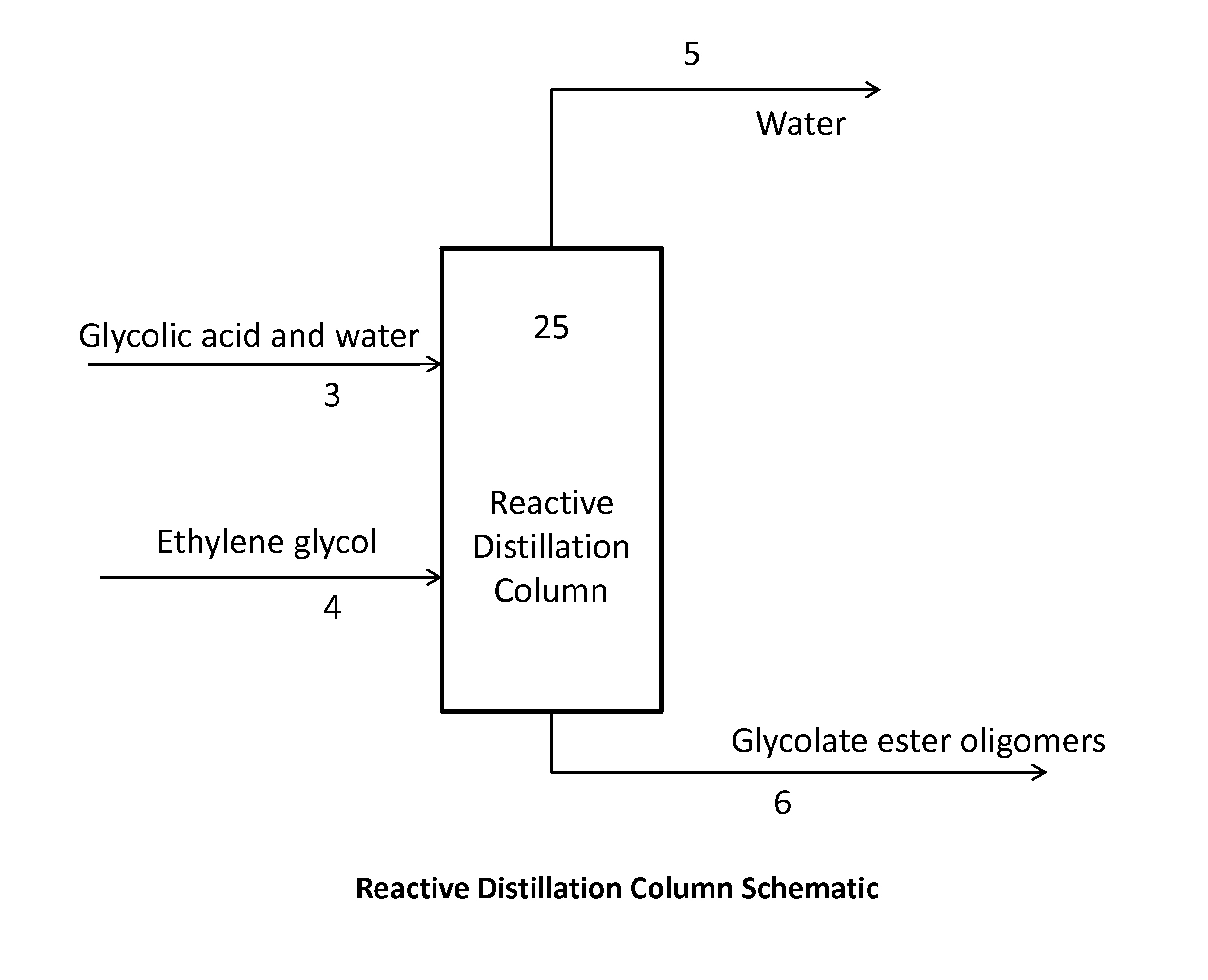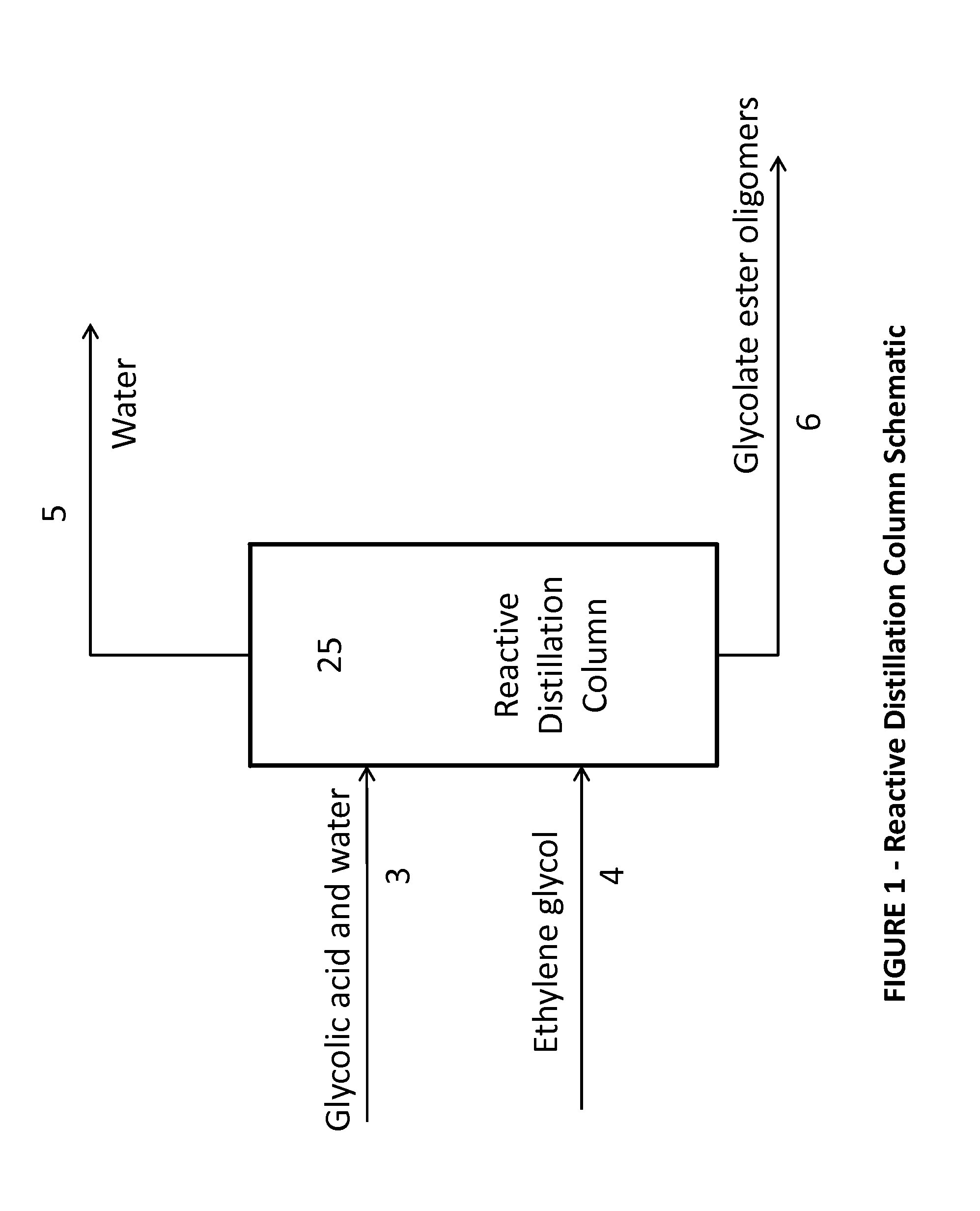Reactive Distillation of a Carboxylic Acid and a Glycol
a technology of carboxylic acid and glycol, which is applied in the field of esterification of aqueous glycolic acid, can solve the problems of undesirable presence of water, and achieve the effect of enhancing the esterification of glycolic acid in equilibrium limited conditions
- Summary
- Abstract
- Description
- Claims
- Application Information
AI Technical Summary
Benefits of technology
Problems solved by technology
Method used
Image
Examples
example 1
[0087]Ethylene glycol and aqueous glycolic acid were purchased and used without further processing. A 1 inch Oldershaw column with 30 trays (excluding the condenser and reboiler) was fed aqueous glycolic acid and ethylene glycol at stage 20, counted from the bottom up. The molar feed ratio of glycolic acid to ethylene glycol was targeted at 1:1. The top pressure of the distillation column, as measured at the vacuum pump, was maintained at 250 mmHg. The column reboiler was glass jacketed and heated with oil from an external oil bath such that the base temperature was controlled at 165° C. The reactive distillation column was run long enough to ensure steady state performance. Two composition measurements were taken 60 minutes apart in time. The reactive distillation column conditions and results are shown in Tables 1 and 2. The Bottoms composition of water plus acid-ends for each sample measurement is listed in Table 2 as sample 1(a) and 1(b), respectively.
TABLE 1Average Reactive Dis...
examples 2-7
[0090]Examples 2 through 7 were run in the same manner as Example 1 except the feed location, top pressure, bottom temperature, and / or molar feed ratio were varied as given in Table 1. For all Examples except for Example 6, multiple measurements were made during the experiment. These measurements were taken between 30 and 90 minutes apart in time and are listed as (a) and (b) results for each Example.
examples 8 and 9
[0091]Examples 8 and 9 were run in the same manner as Example 1 except, in addition to changes in the feed location, top pressure, bottom temperature, and / or molar feed ratio as given in Table 1, trace components were added to the glycolic acid feed such that the glycolic acid feed stream contained 1 wt % formic acid, 1.3 wt % oxydiacetic acid, 0.59 wt % methoxyacetic acid, and 0.0132 wt % formaldehyde. The formic acid, methoxyacetic acid, and glycolic acid distributed essentially completely to the bottoms product. The formaldehyde material balance was not internally consistent. In addition to formaldehyde being present in a small quantities and consequently relative susceptible to measurement error, glycolic acid can decompose to form formaldehyde. Additionally, the experimental set-up had a much higher residence time in the base of the distillation column than would be present in a commercial set-up, causing a greater amount of formaldehyde formation. The formaldehyde appeared to ...
PUM
| Property | Measurement | Unit |
|---|---|---|
| pressure | aaaaa | aaaaa |
| temperature | aaaaa | aaaaa |
| pressure | aaaaa | aaaaa |
Abstract
Description
Claims
Application Information
 Login to View More
Login to View More - R&D
- Intellectual Property
- Life Sciences
- Materials
- Tech Scout
- Unparalleled Data Quality
- Higher Quality Content
- 60% Fewer Hallucinations
Browse by: Latest US Patents, China's latest patents, Technical Efficacy Thesaurus, Application Domain, Technology Topic, Popular Technical Reports.
© 2025 PatSnap. All rights reserved.Legal|Privacy policy|Modern Slavery Act Transparency Statement|Sitemap|About US| Contact US: help@patsnap.com



